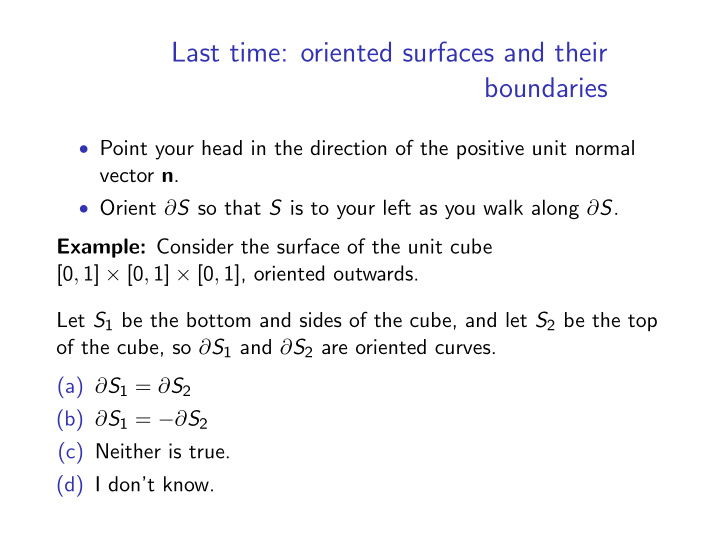



Last time: oriented surfaces and their boundaries ∙ Point your head in the direction of the positive unit normal vector n . ∙ Orient ∂ S so that S is to your left as you walk along ∂ S . Example: Consider the surface of the unit cube [0 , 1] × [0 , 1] × [0 , 1], oriented outwards. Let S 1 be the bottom and sides of the cube, and let S 2 be the top of the cube, so ∂ S 1 and ∂ S 2 are oriented curves. (a) ∂ S 1 = ∂ S 2 (b) ∂ S 1 = − ∂ S 2 (c) Neither is true. (d) I don’t know.
Announcements ∙ Deadline to request a regrade for midterm 3 is this Thursday. ∙ Final exam is next Friday. (!) I will organize some kind of review session next Wednesday/Thursday/Friday. Fill out the survey on the course webpage indicating your availability if you’re interested.
More on Stokes’ Theorem and Curl Recall: ∙ We assume we have a vector field F defined on some open region D ⊂ R 3 , with continuous first order partial derivatives on D . ∙ S is an oriented surface contained in D . We assume S is “nice”: • S is piecewise smooth. • ∂ S consists of one or more simple closed paths. Theorem (Stokes’ Theorem) ∫︂∫︂ ∫︂ curl F · d S = F · d r . S ∂ S
More on Stokes’ Theorem and Curl Let F be the velocity field of a fluid flow in R 3 . Choose a point P in R 3 , and choose any vector unit vector n at P . Let D be a small disk with centre P and unit normal n , and place a tiny paddle wheel at P with its axis of rotation in direction n . The counterclockwise force on the wheel is related to the circulation of F around ∂ D : ∫︂ ∼ F · d r . ∂ D But by Stokes’ theorem, this is ∫︂∫︂ curl F · n dA . D
The counterclockwise force on the wheel is related to the circulation of F around ∂ D : ∫︂ ∫︂∫︂ ∼ F · d r = curl F · n dA . ∂ D D We approximate the function curl F · n over the small disk D by its value at the centre point P . ∙ The wheel rotates counterclockwise if curl F · n > 0 at P . ∙ It rotates clockwise if curl F · n < 0 at P . ∙ It doesn’t rotate at all if curl F · n = 0. The speed of rotation is related to | curl · n | . If we want to place a tiny wheel at P oriented so that it will spin as quickly as possible, we should choose the angle/direction n so that | curl · n | is as large as possible. i.e. we should choose n to be pointing in the same direction ( ± ) as curl.
Analogy If f is a function, the gradient ∇ f ( P ) points in the direction we should face if we want to increase as quickly as possible. If F is a vector field, the curl ∇ × F ( P ) points in the direction we should stand if we want to be spun around as quickly as possible.
Practice with Stokes’ theorem: computing a hard surface integral by changing it into an easy surface integral Let S be the blob drawn on the board, oriented outward, with boundary edges of the square [0 , 1] × [0 , 1] × { 1 } . Let F be as before. What is ∫︁∫︁ S curl F · d S ? (a) -1 (b) 0 (c) 1 (d) Not enough information. (e) I don’t know.
Practice with Stokes’ theorem y − x x 2 + y 2 , e z 2 ⟩ . F = ⟨ x 2 + y 2 , This is defined everywhere except the z -axis, { x = y = 0 } . Claim: ⃒ i j k ⃒ ⃒ ⃒ ⃒ ⃒ ∂ x ∂ y ∂ z curl F = = 0 . ⃒ ⃒ y e z 2 ⃒ − x ⃒ ⃒ ⃒ x 2 + y 2 x 2 + y 2
ST: Converting a hard line integral to an easy surface integral Let C 1 be the curve parametrized by r 1 ( θ ) = ⟨ 4 cos θ − cos 4 θ, 1 , 4 sin θ − sin 4 θ ⟩ , 0 ≤ θ ≤ 2 π . Let S be the surface we get by filling in the curve in the y = 1 plane. Observe that S doesn’t intersect the z -axis, so F is defined on all of S . Orient S so that ∂ S = C 1 . Then Stokes’ Theorem says: ∫︂ ∫︂∫︂ F · d r = curl F · d S = 0 . C 1 S
More practice with Stokes’ Theorem Let F be as before, but now let C 2 be the curve parametrized by r 2 ( θ ) = ⟨ 4 cos θ − cos 4 θ, 4 sin θ − sin 4 θ, 1 ⟩ , 0 ≤ θ ≤ 2 π . Does the previous argument work ∫︁ to show that C 2 F · d r = 0? Why or why not? (a) No. (b) Yes.
Recommend
More recommend